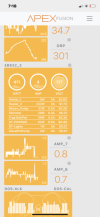Hello
I noticed this and maybe I’m wrong in my math.
If I do the math on my apex. The numbers are all wrong.
Amps X volts = watts
4 amps X 117 volts = 468 watts
But on the apex it’s different.
Also. When I do the same equation on the kilowatt meter. It’s off too. Can someone explain what am I doing wrong ? I’m confused
I noticed this and maybe I’m wrong in my math.
If I do the math on my apex. The numbers are all wrong.
Amps X volts = watts
4 amps X 117 volts = 468 watts
But on the apex it’s different.
Also. When I do the same equation on the kilowatt meter. It’s off too. Can someone explain what am I doing wrong ? I’m confused

